The content of the article
A bedding set is not much different from clothes. Will you wear the same shirt for four months in a row? But on the bed we spend an average of six to eight hours a day. Dead skin particles, sweat, fat and other secretions remain on the bed, which become a favorable environment for the development of various kinds of dangerous microorganisms.
Danger under the covers
The reasons and norms for which it is advised to change clothes regularly, some are shocking. It turns out that under a dirty blanket there are a whole range of potential health threats.
- Dust and mold. The dust present in each apartment can also accumulate where you sleep. There is not only dirt brought in from the street or through a window. It also contains mold spores, bacteria, and other tiny organisms. If you constantly breathe this dust, you can earn allergies, lung problems and weakened immunity.
- Ticks They are very small, and therefore it is difficult to notice them with the naked eye. The main source of nutrition for these insects is dead skin particles, which clog into the fibers of the tissue. Fortunately, parasites do not bite the person and do not spoil the furniture. But if the products of their livelihoods form a tandem with molds, then the sleeping person rarely escapes the allergic reaction.
- Worms. Pinworm eggs, of course, do not appear on the bed by themselves. They remain after the infected person or they can be transferred to your pet's hair. Is it necessary to say that it is extremely difficult to get rid of parasites that have got into the body?
How often do I need to change bedding: norms
Many do not know exactly how many times a month bed linen needs to be changed. In one day? On weekends? Or is it enough to carry out the procedure every 14 days? There is no single correct answer. It is necessary to take into account the situation, who uses the kit (adult or child) and even the time of year. The main recommendations look like this.
- Healthy adults. Change the kit once every seven days - it is very important to adhere to this rule in the summer, when due to intense heat the body releases a lot of fat and sweat. In winter and in the off-season this can be done less often - once every two weeks.
- Sick children and adults. If you or a child caught a chickenpox or other infection, a fever has risen, then it is advisable to change the linen daily until the moment of full recovery.
- Newborns. Change the bedding of the newborn should be contaminated or once a week. But diapers, which are laid on top of oilcloths, may require replacement even several times a day. Especially if the baby is sleeping without a diaper.
- Older children. It is enough for a child of preschool and primary school age to change the kit every 10-14 days. Or as it gets dirty. Children sweat less and, if they follow hygienic procedures, their bed stays fresh longer. In kindergartens kindergartens, according to the standards, the bed changes every ten days.
- Teenagers. Transitional age carries with it a hormonal restructuring of the body, which is characterized by increased work of the sebaceous glands. Therefore, pillowcases and sheets quickly become dirty. This is the situation when you have to wash bedding twice a week.
Rules for washing and disinfecting procedures
How to wash bedding? Check the product label: it contains information on the composition of the fabric, which water temperature is preferable for certain materials, how to care for the kit. Follow these general tips.
- The optimum temperature. Usually sheets, pillowcases and duvet covers are recommended to be washed in the most hot water. Thus, it will be possible to get rid of all bacteria and dirt. But if cotton and linen were used for the production of sets, then the temperature should not be higher than 60 ° C.
- Disinfection. To surely get rid of dangerous microorganisms, the use of chlorine bleaches is allowed. But this is only if the fabric is white. For colored material, you can choose an oxygen product with a more gentle composition, but no less effective.
- Drying. Bacteria do not like hot air and ultraviolet radiation. Therefore, bedding is best dried in the sun.
- Ironing. Many doubt whether it is necessary to iron bedding after washing. This is a mandatory process, which is an additional guarantee that harmful microorganisms are neutralized. Set the “Cotton” mode on the iron and boldly treat the surface of the fabric.
Sleep Care
You already know why often change bedding. But how to organize home care for various bedding?
Sheets and duvet covers
You can not scroll these items in the drum with ordinary things - sweaters, trousers, underwear. Only neighborhood with light bath towels is acceptable. When processing, the following rules from the table should be considered:
- wash sheets and duvet covers with soap or powder at 60 ° C;
- persistent dirt is removed before washing;
- for whitening, you can add a quarter cup of lemon juice when washing;
- Do not dry the bed and iron while the linen is still slightly wet.
A blanket
Wool products prefer cool water and drying at minimum speed. Down products require delicate washing, they are dried in the sun, otherwise a persistent musty smell will appear.
Before starting the process, check for damage or loose seams on the blanket. Otherwise, the entire “filling” will remain inside the washing machine and will render it unusable. After washing and drying, vacuum clean the product without giving dust a chance to stay.
Blankets and bedspreads
Before washing, it is not superfluous to check whether the product sheds. If so, it is better to use dry cleaning services. And at home, adhere to the following rules:
- washing water should be cool;
- ordinary powder is better replaced with liquid;
- the "drying" mode should be at minimum low speeds.
Pillowcases and pillows
To remove dust particles and the stratum corneum of the epidermis, try to whip the pillows every day. Pillowcases adore splashing in hot water. For washing, the same means are used as for other elements of bedding.
Mattress Covers
Mattress covers are lifesaving sticks for those who want to increase the service life of mattresses, protect themselves from allergies and maintain cleanliness. Erase mattress covers according to the same instructions as for duvet covers and sheets. Water procedures should be carried out at least once a month or as pollution occurs.
Knowing how long it takes to change bedding and following these recommendations, you will preserve the aesthetic appearance of the kit and prevent health problems. By the way, in decent hotels a fresh bed is made up not only after the departure of each guest or at the request of those living in the room. In hotels with a solid number of stars, the bed is refreshed several times a day.
And as in practice: reviews
Horror! I can’t imagine that someone changes bedding every three months !!! Even once a month I can’t even imagine it. I change bed linens at least three times a week, so it’s wild to me to think that someone changes it once every three months.
Happy, http://www.mhealth.ru/health/organizm/postelnoe-bele-kak-chasto-ego-nado-stirat-i-pochemu/
I change no more than once every two weeks, I can oversleep for three, but no more. I hate to sleep on clean linen, I have the feeling that I'm all in detergent and air conditioning. And finally I do not bother with this topic.
Rat, http://www.woman.ru/home/medley9/thread/3868292/
I change sheets and pillowcases once a week, the duvet cover can be up to 2 weeks. I buy only Russian satin, so even if you are too lazy to stroke it, it’s nice to the skin anyway.
Miki, http://www.woman.ru/home/medley9/thread/3868292/
Once every 2 weeks I change, I never iron. I straighten it carefully before drying, it becomes ironed. and I’d terribly disdain to wear it in the laundry room, where your linen is touched by Tetka’s other people’s hands (and maybe they didn’t wash their hands after the toilet) ... and cockroaches could run there. )
a guest, http://www.woman.ru/home/medley9/thread/3868292/
Here are all the right gathered. Just like in a hospital. Until recently, I changed my bed once a month. My mother does that, and so do I. I would not say that it has become very dirty in a month. For a week - generally clean. We take a shower before going to bed. Now we have bought a woolen bed, it generally needs to be washed once every half a year.
Venicia, http://babybym.com/threads/kak-chasto-nuzhno-menjat-postelnoe-bele.1806/



